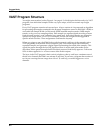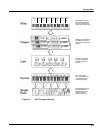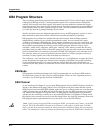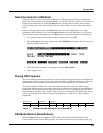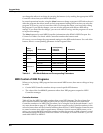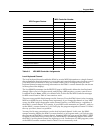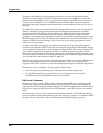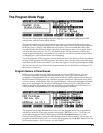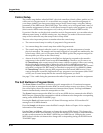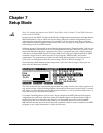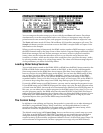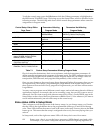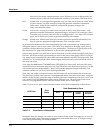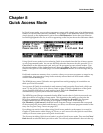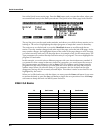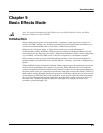
6-10
Program Mode
The Program Mode Page
Control Setup
The control setup defines what the K2661’s physical controllers (wheels, sliders, pedals, etc.) do
while you’re in Program mode. It’s a convenient way to apply the controller assignments in
your setups globally. Just choose an existing setup to be the control setup, using the CtlSetup
parameter on the MIDI-mode TRANSMIT page. Then while you’re in Program mode, many of
the controller assignments for Zone 1 of the control setup also apply to the programs you play
(this is true for MIDI control messages as well, unless you have turned off MIDI control).
If you don’t like the way the physical controllers work in Program mode, you can either select a
different control setup, or edit the existing one. Any changes you make to the current control
setup will also affect the way that setup works in Setup mode.
There are a few important points to remember about the control setup:
• The current control setup is used by all programs in Program mode.
• You cannot change the control setup from within Program mode.
• The control setup doesn’t affect the sound of a program, only the assignments of certain
physical controllers. The samples and keymaps assigned to a program are unaffected by the
control setup. While you’re in Program mode, the K2661 ignores the programs assigned to
the setup that you choose as the control setup.
• Almost all of the VAST programs in the K2661 are designed to respond to the controller
assignments in the default control setup (97 ControlSetup). Therefore you’ll want to use
97 ControlSetup as the control setup in most cases, with two exceptions. When you’re using
the local keyboard channel (that is, when the value of the LocalKbdCh parameter is
anything but None) and playing a KB3 program from an external MIDI source, use a control
setup that’s configured for KB3 control, as described on page 6-8 (if LocalKbdCh is None,
97 ControlSetup is fine for playing KB3 programs from an external MIDI source). If you
want to change the controller assignments for any program or set of programs (either VAST
or KB3), use a control setup that has the controller assignments you want.
See page 7-3 for a table listing the parameters that affect Program-mode controller assignments.
The Soft Buttons in Program Mode
The Octav-/Octav+ buttons are a shortcut for quick transposition in 12-semitone increments.
You can use them to transpose the entire K2661 as much as three octaves up or down. The top
line of the display shows the current amount of transposition (Xpose). Pressing both Octave
buttons simultaneously returns the transposition to zero.
The Octave buttons transpose the K2661, as well as any MIDI devices connected to the K2661’s
MIDI Out port. Changing the transposition with the soft buttons also changes the corresponding
setting on the MIDI-mode TRANSMIT page.
Pressing the Panic soft button sends an All Notes Off message and an All Controllers Off
message on all 16 MIDI channels.
Press the Sample soft button to enter the K2661’s sampler. Refer to Chapter 14 for complete
information on the sampler.
Use the Chan– and Chan+ soft buttons to change the current MIDI channel. This changes the
MIDI channel the K2661 uses internally, as well as the channel you’re using to send information
to other synths connected to the K2661’s MIDI Out port (MIDI slaves). Changing the current
MIDI channel with the soft buttons also changes the corresponding setting on the MIDI-mode
TRANSMIT page.



